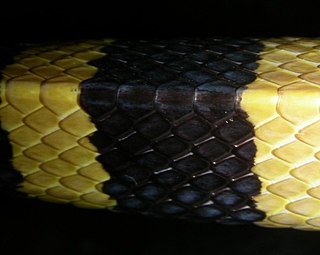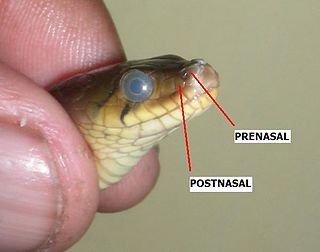 W
WSnakes, like other reptiles, have skin covered in scales. Snakes are entirely covered with scales or scutes of various shapes and sizes, known as snakeskin as a whole. A scale protects the body of the snake, aids it in locomotion, allows moisture to be retained within, alters the surface characteristics such as roughness to aid in camouflage, and in some cases even aids in prey capture. The simple or complex colouration patterns are a property of the underlying skin, but the folded nature of scaled skin allows bright skin to be concealed between scales then revealed in order to startle predators.
 W
WIn snakes, the anal scale is the scale just in front of and covering the cloacal opening. This scale can be either single or paired. When paired, the division is oblique. The anal scale is preceded by the ventral scales and followed by the subcaudal scales.
 W
WThe brille is the layer of transparent, immovable disc-shaped skin or scale covering the eyes of some animals for protection, especially in animals without eyelids. The brille has evolved from a fusion of the upper and lower eyelids. Brille means "spectacles" or "glasses" in German, Norwegian and Danish and "shine" in French and Spanish.
 W
WChin shields or chinshields, genials scales on a snake are scales found on the underside of the snake's head towards the anterior and touching the lower labial scales. Chin shields to the front of the snake are called anterior chin shields while those to the rear of the snake are called posterior chin shields.
 W
WIn snakes, the dorsal scales are the longitudinal series of plates that encircle the body, but do not include the ventral scales.
 W
WFrontal scale refers to the scales of a reptile which lie in the general region of the forehead of a snake, more specifically between the eyes and to the anterior of this area. These are analogous to the frontal bone on a human which corresponds to the forehead.
 W
WIn snakes, the internasal scales are those on top of the head between the scales that surround the nostrils. They are usually paired and situated just behind the rostral.
 W
WKeeled scales refer to reptile scales that, rather than being smooth, have a ridge down the center that may or may not extend to the tip of the scale, making them rough to the touch. According to Street's (1979) description of European lizards and snakes, in those that have keeled scales the keels are usually stronger in male specimens and are consistently arranged according to the species of reptiles, even though many others do not have them. With European lizards, the dorsal scales are usually well keeled, while those on the flanks are more weakly keeled and those on the belly smooth.
 W
WThe lacunolabial scale is a large scale that forms in some crotaline snakes (pitvipers) when the prelacunal scale fuses with the second supralabial scale. In such cases, it is often said that "the second labial enters the pit."
 W
WThe lore is the region between the eyes and nostrils of birds, reptiles, and amphibians.
 W
WIn reptiles, the nasal scale refers to the scale that encloses the nostril.
 W
WIn snakes, the paraventral scales are the longitudinal rows of dorsal scales that contact the ventral scales. These are the first rows of dorsal scales on either side of the body and are usually slightly larger than the scales located more dorsally. In species that have mostly keeled scales, the paraventrals are usually smooth or only weakly keeled.
 W
WParietal scale refers to the scales of a snake which are on the head of the snake and are connected to the frontals towards the posterior. These scales are analogous to and take their name from the parietal bone which forms the roof and sides of the cranium in humans.
 W
WThe prefrontal scales on snakes and other reptiles are the scales connected to the frontals towards the tip of the snout which are in contact with the internasals.
 W
WThe rostral scale, or rostral, in snakes and other scaled reptiles is the median plate on the tip of the snout that borders the mouth opening. It corresponds to the mental scale in the lower jaw. The term pertains to the rostrum, or nose. In snakes, the shape and size of this scale is one of many characteristics used to differentiate species from one another.
 W
WIn snakes, the subcaudal scales are the enlarged plates on the underside of the tail. These scales may be either single or divided (paired) and are preceded by the anal scale.
 W
WIn reptiles, the temporal scales are located on the side of the head between the parietal scales and the supralabial scales, and behind the postocular scales.
 W
WIn snakes, the ventral scales or gastrosteges are the enlarged and transversely elongated scales that extend down the underside of the body from the neck to the anal scale. When counting them, the first is the anteriormost ventral scale that contacts the paraventral (lowermost) row of dorsal scales on either side. The anal scale is not counted.
 W
WVertebral scales, in snakes, are large scales along the top of the back of the snake, i.e., the uppermost row. They are a specialised form of dorsal scales.